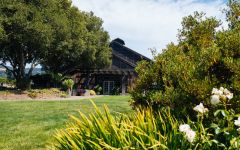Roederer Estate L'Ermitage 2011
-
Wilfred
Wong -
Wine
Enthusiast -
Wine &
Spirits -
Robert
Parker -
Wine
Spectator



Product Details
Your Rating
Somm Note
Winemaker Notes
Fine tiny bubbles and a long lasting mousse are the usual footprints of the L'Ermitage cuvee. Delicate aromas boast hazelnut, pastry, and pear. Mouthfeel is very pure, focused freshness wrapped in yeast creaminess. Lemon curd and nutty characters play together to give a very European tasting experience.
Blend: 52% Chardonnay, 48% Pinot Noir
Professional Ratings
-
Wilfred Wong of Wine.com
COMMENTARY: Roederer Estate L'Ermitage is one of the world's top sparkling wines. In tasting through the years, I have always found the wines to exhibit superb balance and breed. TASTING NOTES: The 2011 L'Ermitage by Roederer Estate shows precise green apple and mineral aromas and flavors. The wine's palate is finely structured. Pair its crisp finish with fresh salmon sashimi with a light accent of lemon zest. (Tasted: April 4, 2018, San Francisco, CA)
-
Wine Enthusiast
Dry and nicely mature, this complex wine is always among California's best bubblies. It combines great balance, tiny bubbles and some very interesting flavors that make it as appealing as a well-cellared white Burgundy at its peak. Hints of toast, butter and almond fill the aroma, and lemon, crisp apple and baking spices fill the palate. It has lively acidity that's softened by a good sense of body. Editors’ Choice
-
Wine & Spirits
When Jean-Claude Rouzaud searched out a site for Roederer’s California sparkling wine estate, he settled on a cool spot for chardonnay and pinot noir—where vines could deliver flavor depth in their grapes before sugars rose to levels unsuited for sparkling wine. This 2011 is a vindication of that decision, a fragrant, elegant sparkling wine from a cool season, with flavor depth that sets it apart. Notes of fresh apple, honeysuckle and jasmine layer over an herbal austerity that tightens up the wine’s fruit, ending savory. That length of flavor is amplified by a small addition of reserve wines (four percent), aged five years in oak. Arnaud Weyrich blended it in a style formed and determined by its site, resulting in an honest, clean sparkler destined to become a classic.
-
Robert Parker's Wine Advocate
Made with about nine grams per liter dosage and disgorged in March of 2017, the 2011 L'Ermitage Brut is drinking beautifully now but has plenty of room to grow. The nose opens shyly, slowly offering candle smoke, mushroom and toast with underlying red apples. The palate is surprisingly layered and very long, its savory notes opposed by saline notions and fresh acidic lift and enlivened by a creamy mousse. Winemaker Arnaud Weyrich says 2011 was the second time that grapes in Champagne were harvested before those in Anderson Valley, when the season there was a touch warmer than in Anderson Valley.
-
Wine Spectator
Opulent and lush, but elegantly complex, with vivid fresh ginger, cinnamon roll and red berry aromas opening to rich, seamless apple and almond flavors that unfurl on the long finish. Drink now.
Other Vintages
2017-
James
Suckling -
Wine
Spectator
-
James
Suckling -
Wine
Enthusiast -
Wine
Spectator -
Connoisseurs'
Guide -
Wine &
Spirits -
Robert
Parker
-
Wilfred
Wong -
Wine
Enthusiast -
The Somm
Journal -
Robert
Parker -
Wine &
Spirits -
Connoisseurs'
Guide
-
Wine
Enthusiast -
Wine
Spectator -
Robert
Parker
-
Wilfred
Wong -
Robert
Parker -
Wine
Spectator -
Wine &
Spirits
-
Wilfred
Wong -
Wine
Enthusiast -
Wine
Spectator -
Wine &
Spirits
-
Wilfred
Wong -
Wine
Enthusiast -
Robert
Parker -
Wine
Spectator -
Wine &
Spirits
-
Wilfred
Wong -
Wine &
Spirits -
Wine
Spectator
-
Wine
Enthusiast -
Wilfred
Wong -
Wine
Spectator -
Wine &
Spirits
-
Wine
Enthusiast -
Wilfred
Wong -
Wine &
Spirits -
Wine
Spectator -
Robert
Parker
-
Wine &
Spirits -
Wine
Enthusiast -
Wine
Spectator
-
Robert
Parker -
Wine
Enthusiast -
Wilfred
Wong
-
Robert
Parker -
Wine
Enthusiast
-
Wine
Enthusiast -
Wine &
Spirits -
Wine
Spectator
-
Wine
Enthusiast
-
Wilfred
Wong -
Robert
Parker -
Wine
Enthusiast
-
Wine
Spectator






Founded in 1982, Roederer Estate is nestled in Mendocino County’s fog-shrouded, Anderson Valley. As the California property of Champagne Louis Roederer, Roederer Estate builds upon a centuries-old tradition of fine winemaking. Roederer's unique winemaking style is based on two elements: complete ownership of its vineyards and the addition of oak-aged reserve wines to each year's blend or cuvee to create complex, dry and harmonious sparkling wines.
The crisp, fresh and rich flavors of Roederer Estate sparkling wines reflect the cool Anderson Valley that is home to their family-owned estate's 600 acres of vineyards. This protected valley in Northern California provides the ideal ripening conditions for their 100% estate-grown Pinot Noir and Chardonnay grapes. The blending team is comprised of the winemakers from the California property as well as from Champagne Louis Roederer, ensuring that Roederer Estate remains the most French of the California sparklers.

Representing the topmost expression of a Champagne house, a vintage Champagne is one made from the produce of a single, superior harvest year. Vintage Champagnes account for a mere 5% of total Champagne production and are produced about three times in a decade. Champagne is typically made as a blend of multiple years in order to preserve the house style; these will have non-vintage, or simply, NV on the label. The term, "vintage," as it applies to all wine, simply means a single harvest year.

Surrounded by redwood forests and often blanketed in chilly, ocean fog, the Anderson Valley is one of California’s most picturesque appellations. During the growing season, moist, cool, late afternoon air flows in from the Pacific Ocean along the Navarro River and over the valley's golden, oak-studded hills. High and low temperatures can vary as much as 40 or 50 degrees within a single day, allowing for slow and gentle ripening of grapes, which will in turn create elegantly balanced wines.
The Anderson Valley is best known for Pinot Noir made in a range of styles from delicate and floral to powerful and concentrated. Chardonnay also shines here, and both varieties are often utilized for the production of some of California’s best traditional method sparkling wines. The region also draws inspiration from Alsace and produces excellent Riesling, Gewürztraminer, Pinot Blanc and Pinot Gris.
